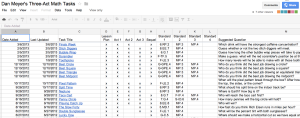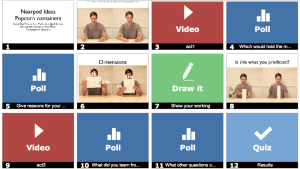Before we start educating them, it makes sense to ask the question what makes a great scientist?
Curiosity?
The ability to ask astute questions ?
Being able to consider innovative and divergent strategies for getting the answers?
Having the capability to create valid experiments and spotting flaws in techniques and patterns/ anomalies in results?
Have a sufficient depth of knowledge to connect concepts to reach the Extended Abstract level of SOLO Taxonomy?
To be able to evaluate and extend understanding with more investigations?
How well does our education system facilitate the development of great scientists?
Often very poorly. All too often we teach from the bottom up; tell stories where the answers are already known. In many lessons no conflict is created, nor curiosity excited; no creativity is allowed and students are limited by the outcome.
In short, often students are taught merely to decode exam questions and performance takes the place of real learning.
Teachers complain of students lacking:
- Initiative
- Independence
- Resilience
- Thinking skills
- Communication skills
This is not entirely our students fault. Our education system is not designed to encourage creativity and free thinking, but geared towards conformity and mass production. Complaining that our students lack these skills is the equivalent of moaning that cars don’t fly.
With an education system that is exam orientated and risk averse it is easy to see why students are spoon fed and a cycle of dependency created.
How can we break the cycle and move away from this sanitised science experience?
Using Dan Meyer’s inspirational @ddmeyer Three Act Maths http://blog.mrmeyer.com/?p=10285 as a model, we can incorporate multimedia and digital tools to redefine the learning experience. This is one example of transformational practice
What might we do?
- Use multimedia and digital tools
- Let them use their intuition
- Let the students build the problem by asking questions themselves
- Have them share their discoveries and evaluate each others technique
- Be less helpful
If you only do one of these do the last: as a teacher it is incredibly difficult to acheive. When delivering teacher training I often use a magic box that there is a strategy to open, which is difficult to discover. I use it to demonstrate that invoking curiosity as a starting point, is much more powerful than the ‘bottom up’ approach. We would normally teach this as ‘here is a box, here is how to open the box, then give it to them and they would be able to open it’. This completely removes the joy of discovery and makes it very boring. The interesting thing when doing this activity with teachers, is that when they learn to open the box, most immediately feel compelled to tell other people how to do it, thus killing the learning experience. The box is only interesting when you can’t open it. No other group I have tried it with suffers this compulsion. In fact a group of bankers used it to prove their superiority and wouldn’t dream of helping others!
I would like to propose a Three Act model for improving the delivery of science and would welcome collaboration, comments and criticism in the development of this.
The Three Act structure is already used by Screenwriters who know lots about how to engage our interest:
http://www.writerswrite.com/screenwriting/lecture4.htm
It sounds horribly like the formulaic OFSTED three part lesson , but please bear with me. You break your lesson down intothree parts: Act One, Act Two, Act Three. Beginning, middle, end. Setup, problem solving, resolution.
Act One is the hook. The purpose of the first act is to engage the students. It must be unique, something they haven’t seen or considered before. They are then encouraged to ask questions and build the problem themselves; to make predictions and use their intuition. Most people understand far more physics than they realise – for example: they don’t fall over as they understand centre of mass. What many lack is the ability to communicate this understanding in a conventional scientific way.
An example is here: (The idea is stolen from one of the finest minds in physics I know: Dr Lawrence Cattermole)

If you cannot see the video there are three cartons of juice: one full, one half full, one empty. The full one is pushed over until it falls.
So what questions does this invoke?
The questions can be narrowed. The highly talented Tom Harbour (a beacon for Teach First ) at a school in Leicester gets his classes to ask superb questions using his “What would happen if…?” format.
Some questions they may come up with:
Which is the most stable? (This then generates more questions – do we mean which falls at the greatest angle, or which needs the biggest force to push them over?)
In which order will they fall over when pushed, from the first to fall over to the last?
Which requires the biggest force to push it over?
How much juice will make it the most stable? (This is massively more complicated than you may think!)
Which is most likely to get knocked over – an empty , full or half full glass, if you knocked them in passing ? (real life example – that gets even more tricky as the shapes of glasses will affect this)
Act Two: Ideas are generated towards a resolution of the problem. Engagement is increased as the key aspects of motivation are in place: Mastery, Autonomy and Purpose – See Dan Pink here
This is the stage where they can explore their understanding and knowledge can be added if needed. Allow them to make mistakes and follow wrong lines of enquiry.
They can then plan and carry out their investigation into stability to find out answers.
Digital technology used to follow their learning journey can be transformative. Videos used to show what they predicted, what they did and what they were thinking offer great insight.
Apps such as Socrative, Showbie and Nearpod allow questions from the students to be compiled and progress to be shown. I will be developing examples of these in the future
Act Three is the reveal, the resolution to the dilemma. This ideally should be shown, if possible through the video or demonstration, rather than simply being told the answer. This builds tension and often gets the release – “Yess!!” Though for some of the activities the “right” answer is unknown and there are no limits to what students can achieve.
So what is the solution to the juice carton stability problem?
Find out for yourself!
( Contact me if you haven’t access to a carton!)
Please add comments and feel free to share and collaborate, this is not a commercial product.








